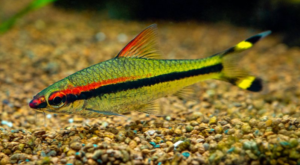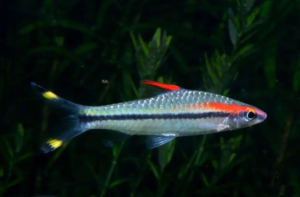Denison Barb Lifespan: How to Ensure A Long Healthy Life For Your Denison Barb

Denison Barb
Unveiling the Mystique of Denison Barbs: Origin, Uniqueness, Care Essentials, and Balanced Diet
In the enchanting world of freshwater aquariums, one fish species stands out for its vibrant colors, distinctive appearance, and captivating behavior – the Denison Barb, also known as the Roseline Shark. As an experienced Denison Barb enthusiast, I’m thrilled to take you on a journey into the realm of these remarkable fish. In this article, we’ll explore their origin, delve into why they are a unique species, discuss their specific care requirements for a thriving living environment, and reveal the secrets to providing them with a balanced diet.
Here is a table of the average lifespan of Denison Barb species:
Breed |
Average Lifespan |
Unique Appearance |
|---|---|---|
Original Denison Barb (Sahyadria denisonii) |
6 – 8 years |
Bright red lateral line, silver-gray body |
Green Denison Barb (Sahyadria denisonii ‘Green’) |
6 – 8 years |
Similar to the original Denison Barb but with a greenish tint |
Gold Denison Barb (Sahyadria denisonii ‘Gold’) |
6 – 8 years |
Golden coloration in place of the red lateral line |
Albino Denison Barb (Sahyadria denisonii ‘Albino’) |
6 – 8 years |
Completely white or albino coloration |
Origin of the Denison Barb
The Denison Barb, scientifically known as Sahyadria denisonii, hails from the Western Ghats region in India, a place of immense biodiversity. They were first discovered in the fast-flowing rivers and streams of the Western Ghats, where they showcased their distinctive red lateral line and streamlined body. Over the years, this fascinating fish has captured the hearts of aquarists worldwide, earning its place in the world of ornamental fishkeeping.
Uniqueness of Denison Barbs
1. Stunning Appearance
Denison Barbs are renowned for their striking appearance. Their bright red lateral line extends from the snout to the tail, contrasting beautifully against the silver-gray body. The distinctive look of Denison Barbs makes them an eye-catching addition to any aquarium.
2. Social Behavior
These fish are known for their active and social behavior. They thrive in the company of their own kind and other peaceful species. When kept in groups, they display playful interactions and can be a joy to observe.
3. Swimming Agility
Denison Barbs are agile swimmers, known for their graceful movements. They appreciate open spaces to swim and explore, making them a dynamic addition to larger aquariums.
Care Essentials for Denison Barbs
1. Aquarium Size
To provide Denison Barbs with a proper living environment, opt for a spacious aquarium. A tank size of at least 55 gallons is recommended for a small group of Denison Barbs. The extra space allows them to swim freely and exhibit their natural behavior.
2. Water Parameters
Maintaining stable water conditions is crucial. Denison Barbs prefer slightly acidic to neutral water (pH 6.5-7.5) and a temperature range of 72-79°F (22-26°C). High-quality filtration is essential to keep the water clean and well-oxygenated.
3. Tank Décor
Create a natural environment in your aquarium by adding live plants, rocks, and driftwood. These elements provide hiding spots and mimic the Denison Barb’s native habitat. The addition of fine-gravel substrate completes the setup.
4. Group Dynamics
Denison Barbs are shoaling fish and thrive in groups of five or more. Keeping them in smaller groups can lead to stress and aggression. Observing their lively interactions within a shoal is a sight to behold.

Denison Barb
Enclosures for Denison Barbs
The choice of enclosure for Denison Barbs is crucial for their well-being. Here are some types of enclosures suitable for these remarkable fish:
1. Glass Aquarium
A glass aquarium is the most popular choice for housing Denison Barbs. Its transparency allows you to enjoy the full splendor of these fish, and it provides a secure environment for their needs.
2. Planted Aquarium
A planted aquarium, filled with live aquatic plants, replicates their natural habitat and enhances the overall aesthetics of your tank. Live plants also help maintain water quality.
3. Species-Specific Aquarium
Some aquarists choose to create species-specific aquariums, dedicated solely to Denison Barbs. These setups often include rocks, driftwood, and a sandy substrate to mimic their native rivers.
4. Community Aquarium
Denison Barbs are peaceful by nature and can coexist with other non-aggressive fish species like tetras, rasboras, and loaches. A well-planned community aquarium can be a visually stunning and harmonious habitat.
Balanced Diet for Denison Barbs
Feeding your Denison Barbs a balanced diet is essential for their health and vibrancy. Here’s a guide to their dietary needs:
1. High-Quality Pellets and Flakes
A staple diet of high-quality tropical fish pellets and flakes provides the necessary nutrients. Look for products with a high protein content to support their growth and vitality.
2. Frozen and Live Foods
Variety is key to a Denison Barb’s diet. Supplement their diet with frozen or live foods such as brine shrimp, daphnia, and bloodworms. These treats mimic their natural prey in the wild and provide essential nutrients.
3. Fresh Vegetables
Occasionally offer blanched vegetables like spinach or zucchini to provide fiber and essential vitamins. Ensure that these vegetables are cut into small, manageable pieces.
4. Feeding Frequency
Feed your Denison Barbs small, frequent meals rather than one large serving. This approach aligns with their natural feeding behavior and prevents overeating.
Denison Barbs are undoubtedly one of the most captivating species in the world of aquarium fishkeeping. Their origin, unique characteristics, care requirements, and dietary needs make them a rewarding addition to any aquarium enthusiast’s collection. By understanding their origins and providing the proper living environment and balanced diet, you can ensure that your Denison Barbs thrive and continue to enchant with their beauty and behavior in your aquatic haven.
Free Reports
- Cockatiel Sounds: What Type of Sounds Do Cockatiels Make?
- Cane Corso Lab Mix: What You Need To Know Before Adopting Your New Cane Corso Lab Mix
- Belgian Malinois Grooming: How to Properly Care For Your Belgian Malinois
- Hamster Vomiting: What You Need To Do When Your Hamster is Vomiting
- Manchester Terrier Price: What You Should Before Adopting Your Manchester Terrier
- Boerboel Life Span: How Long Do Boerboel Dogs Usually Live?
- Canaan Dog Price: Everything You Should Know About Canaan Dogs Before Adopting
- Do Cane Corso Shed: How Much Cane Corsos Shed and How to Prevent Shedding
- Cane Corso German Shepherd Mix: Everything They Don’t Tell You About This Unique Mix
- Cane Corso Doberman Mix: Check Before You Buy! What They Don’t Tell You About Cane Corso Doberman Mixes
- Brindle Cane Corso: What You Need to Know Before Adopting
- Cockatiel Eye Problems: What to Do When Your Cockatiel Has an Eye Infection
- Top 25 Sun Conure Names: How to Name a Sun Conure, Care Tips and Tricks
- Friesian Horse Price: Everything You Need to Know Before You Buy a Friesian Horse
- Friesian Colors: The Uniqueness of Every Friesian Horse Color, Price and Care Tips